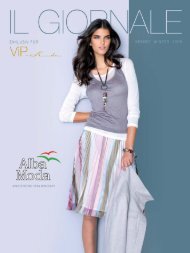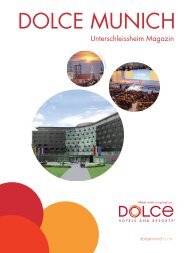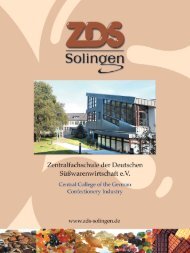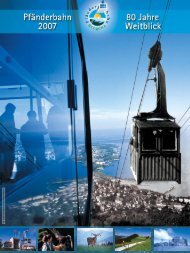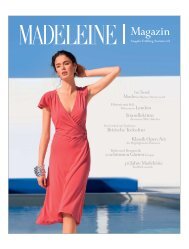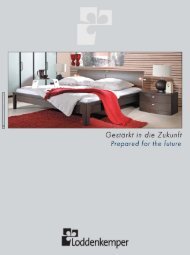mtu_2 - Referenzen.frehner-consulting.de
mtu_2 - Referenzen.frehner-consulting.de
mtu_2 - Referenzen.frehner-consulting.de
Create successful ePaper yourself
Turn your PDF publications into a flip-book with our unique Google optimized e-Paper software.
Technological History<br />
as Brand I<strong>de</strong>ntity.<br />
Mega sailing yachts and MTU have long since<br />
become virtually synonymous. They constitute a<br />
global benchmark for the ultimate in propulsion<br />
system performance and user-friendliness. But<br />
more than that, they represent a glittering<br />
epoch in European technological history in<br />
general and engine production in particular.<br />
That period is associated with a famous name –<br />
Maybach. A name that began the history of<br />
MTU. And one that remains a symbol of the<br />
quality of MTU engine technology today.<br />
Maybach and MTU are names that have stood for inventive<br />
genius, engineering quality and manufacturing performance<br />
for generations. Both have their roots in Friedrichshafen<br />
on Lake Constance where Maybach Motorenbau<br />
GmbH set up in 1912 to build engines for Count Zeppelin's<br />
airships. The importance and achievements of the<br />
present-day DaimlerChrysler subsidiary MTU as a producer<br />
of high-performance diesel engines and complete propulsion<br />
systems for off-highway applications would have<br />
been inconceivable without those beginnings.<br />
Pioneers who Set Standards<br />
Wilhelm and Karl Maybach had foun<strong>de</strong>d their enginebuilding<br />
business in the town of Bissingen on the river<br />
Enz in 1909. The two Maybachs – father and son –<br />
gained wi<strong>de</strong> recognition in the automobile industry as<br />
well. Between 1919 and 1941, Maybach ma<strong>de</strong> luxury<br />
limousines. They embodied the essence of automotive<br />
style and elegance. All 1800 cars built by Maybach were<br />
of the highest quality. And it was they that established<br />
the brand's reputation for luxury, exclusivity and individuality.<br />
In 1929, Maybach caught the attention of the motoring<br />
world with an exceptional product – Germany's first 12-<br />
cylin<strong>de</strong>r car, the Maybach Type 12. The mo<strong>de</strong>l became a<br />
symbol for extravagance, luxury and high performance.<br />
And the fact that its engine was a down sized <strong>de</strong>rivative<br />
of the engine that powered the famous Zeppelin airships<br />
that had captured the imagination of the world with their<br />
transatlantic flights further enhanced the Maybach<br />
legend and its worldwi<strong>de</strong> appeal. Appropriately, Karl<br />
Maybach called his top mo<strong>de</strong>l the "Zeppelin" from 1931<br />
onwards.<br />
Unlimited Applications<br />
on Land, Sea and in the Air<br />
Exclusivity provi<strong>de</strong>s no guarantee of expansion. In the<br />
1920s and 30s, only small numbers of the high-performance<br />
zeppelin engines could be sold. Maybach looked<br />
for new areas of application. They presented themselves<br />
through the product itself. Precisely those characteristics<br />
that gave the Maybach 12-cylin<strong>de</strong>r its outstanding qualities<br />
as an airship engine also ma<strong>de</strong> it the i<strong>de</strong>al power unit<br />
for racing speedboats and fast yachts. And that proved to<br />
be the case in practice. Almost inevitably, the "Type VL"<br />
became the engine of choice for "express cruisers", the<br />
pre<strong>de</strong>cessors of today's mega-yachts.<br />
It was the gol<strong>de</strong>n age of sailing, a time of society get-togethers<br />
on polished <strong>de</strong>cks with canvas overhead. German<br />
and American shipyards built a large variety of impressive<br />
motor yachts – between 100 and 300 feet long and<br />
fitted with Maybach Type VL 2 airship engines. Smaller<br />
craft were equipped with Maybach six-cylin<strong>de</strong>r gasoline<br />
power units, the marine versions of proven car engines.<br />
Such express or racing cruisers offered high performance,<br />
a long range and luxurious interiors. With two or<br />
three V12 engines each producing 570 horsepower (419<br />
kW), the faster among them could reach top speeds of up<br />
to 56 kph.<br />
A typical press review from around 1930 conclu<strong>de</strong>d,<br />
"Those who want the best and most reliable for their<br />
boats choose Maybach engines."




